(click on photos to enlarge image)
MARKS USED BY NORBLIN / BROS. BUCH / N.B.W. COMPANIES ON SILVER-PLATED HOLLOW WARE
Before listing of Norblin/Bros. Buch/N.B.W. marks, it should be reminded that in Russia before 1850s, all silver-plated objects were
produced by soldering of a thin sheet of silver to a red-heated copper plate with subsequent rolling (so-called, rolled silver technique). Such a copper base with a fused silver
layer was called "SILVER PLATE" or simply "PLATE" ("PLAQUÉ" in French, "PLATER" in Polish). In 1850s, the revolutionary method of silver
deposition on the surface of a base metal using the electrolysis process under high voltage was implemented. The great advantage of "galvanic" approach was the possibility
of deposition of a very thin silver layer, which led to economic consumption of precious metal and significant decrease in price for the final product. Towards the end of the XIXth
century the galvanic method of silver deposition practically replaced the old rolled-silver technique. Nevertheless, until now in Polish and English literature the confusion remains,
the Polish term "PLATER" and the English term "PLATE" refer simultaneously to both, old (rolled) and new (galvanic) silver deposition techniques.
 |
A silver-plated candlestick, made by Norblin and Co in 1848.
Private collection of Joanna Paprocka-Gajek. |
In current article the new listing of Norblin/N.B.W. marks (including early Bros. Buch marks) is given. In comparison with our previous works, the following main changes were done.
According to recently found data, the periods of Norblin's privilege possessing were established as 1882-1893 and 1896-1915. For the first time, the Norblin marks of independent
Poland were listed, the important difference from tsarist Russia marks were underlined.
Some export marks of Norblin/Bros. Buch/N.B.W. companies are also given for the first time. However, this list doesn't contain either cutlery marks or so-called small marks, used
in the case of the shortage of space for marking, i.e., when marking the bottom rim of a tea glass holder. This is certainly an area for a future work.
Marks used by Norblin (1843-1893) and N.B.W. (1893-1939) companies.
|
N°
|
PERIOD, MARK & COMMENT
|
|
1
|
1843 - 1851



The earliest known mark of Norblin which refers to the rolled silver deposition (silver plating on copper base). It has the inscription in Polish "WARSZAWA NORBLIN & Co" ("WARSAW NORBLIN & Co") + the year of production inside the oval. There are two varieties of this mark: with more round (1846) and more prolonged (1848, 1850) oval. In the first case the inscription "NORBLIN & Co" is made in two lines, while in the second case - in a single row. Very rare.
|
|
2
|
1851 - 1857

Next Norblin mark which also refers to the rolled silver deposition (silver plating on copper base). It has the inscription in Polish "WARSZAWA NORBLIN & Co" ("WARSAW NORBLIN & Co") inside the oval + one French word "PLAQUÉ" under the oval. Very rare.
|
|
3
|
1853 - 1857


The first Norblin mark which refers to the galvanic silver deposition (silver plating on brass/copper base). Contrary to the previous mark this one displays a dot (!) after the word "PLAQUÉ" or has the word "PLAQUÉ" placed in a cartouche. Very rare.
|
|
4
|
1857 - 1864

Next Norblin mark which refers to the rolled silver deposition (silver plating on copper base). It characterized by a more round oval and by the two-line inscription "NORBLIN & Co".
|
|
5
|
c.1857 - c.1864




Next Norblin mark which refers to the galvanic silver deposition (silver plating on brass/copper base). It also characterized by a more round oval and the two-line inscription "NORBLIN & Co". Note the appearance of the dot after the word "PLAQUÉ" or the use of the word "PLAQUÉ" in a cartouche. Later, following the marking introduced by Fraget firm in the same period, additionally the rhombus with "N" letter was used. This latin letter "N" means "normal thickness of silver deposited onto the surface of the base metal" (usually on brass, sometimes on copper). Very rare/ Extremely rare.
|
|
6
|
c.1864 - c.1872

This Norblin mark refers to the rolled silver deposition (silver plating on copper base). It differs from the previous mark No.4 by the absence of the oval. Instead, the Polish inscription "NORBLIN & Co WARSZAWA" ("NORBLIN & Co WARSAW") itself forms the new oval, in the centre of which another Polish word "PLATER" ("PLATE") is situated. To the left and to the right of the word "PLATER", the stylized French symbol "Fleur de Lis" (lily flower) is placed. Very rare.
|
|
7
|
c.1864 - c.1872





Next Norblin mark refers to the galvanic silver deposition (silver plating on brass/copper base). It differs from the previous mark No.6 by another Polish
inscription put in the centre of the oval. Instead of the word "PLATER", the abbreviation "GALW" from the Polish word "GALWANIZACJA"
("GALVANISATION") is used. Note the colon (!) after the inscription "GALW", which is made of two quadratic points. The sign "GALW: " follows
the marking, used by another Warsaw company (Fraget) mark in the same period. The size of the oval is about 7 mm x 9 mm. Similar to the mark No.6, the stylized French symbol
"Fleur de Lis" (lily flower) is used. In later issues during this period, the small oval with "N" letter appears, which is again similar to the marks used
by Fraget foundry. This small oval with "N" letter means the "normal thickness of silver deposited onto the surface of the base metal
(usually on brass)". Finally, in the late issues of this mark, the circle with the swan image under the Star of David was applied. Rare.
|
|
8
|
c.1872 - 1882


Next Norblin mark refers to the fusion-based silver deposition (silver plating on copper base). It consists of Polish inscription "NORBLIN & Co PLATER WARSZAWA" ("NORBLIN & Co PLATE WARSAW") placed inside the oval, the size of which is about 7.8 mm x 9.4 mm. Note the famous French symbol "Fleur de Lis" (lily flower), put to the left and to the right of the inscription "PLATER", which is probably connected with the French origin of Norblin company. Sometimes, the circle with the swan image under the Star of David was also applied. Very rare.
|
|
9
|
c.1872

A similar mark for the galvanic silver deposition (silver plating on brass/copper base). Contrary to the mark No.7, this mark contains the "N" letter inside the rhombus. This mark is probably a pattern and therefore extremely rare.
|
|
10
|
c.1872 - 1882






Next Norblin mark refers to the galvanic silver deposition. It differs from the previous mark No.9: firstly, by the appearance of a dot (!) after the
word "WARSZAWA" and, secondly, by the disappearance of the "Fleur de Lis" sign. The mean size of the oval is 8 mm x 10 mm. The letter "N" inside a rhombus (or, more rarely, inside a small oval), is commonly used. That means "normal thickness of silver deposited onto the surface of the base metal (usually on brass)". In some cases, the circle with the swan image under the Star of David appears. Note, that two varieties of the Star of David were used, the old, a simple one, and the new, more sophisticated. This mark is common, but some its varieties are rare.
|
|
11
|
c.1882

After getting the privilege of using the Coat of Arms of Russian Empire on its items, the Norblin company stamped all already issued (but yet unsold)
articles with the image of two-headed eagle (version with a "separated" crown above the eagle). This mark refers to the rolled-silver deposition. It was used in a short period after 1882.
|
|
12
|
c.1882

Here is the corresponding mark for the galvanic silver deposition, which was also used in a short period after 1882. Again the eagle version with a
"separated" crown above was used.
|
|
13
|
1882 - 1893








Next Norblin mark refers to the galvanic silver deposition. It differs from the mark No.10 by two characteristic details: firstly, by the presence of the
Coat of Arms of Russian Empire (the eagle version with a "separated" crown above), and, secondly, by the disappearance of the dot after the word "WARSZAWA"
("WARSAW"). Attention! Very often one of two points in the colon after the word "GALW" is missing. Maybe, it is a kind of carelessness. However, similar
carelessness is not observed amongst all other marks of Norblin/N.B.W. Therefore, it is more probable that during the considered period (1882-1893) a gradual evolution of the
mark from "GALW: " to "GALW." took place. The size of the oval varies between 8.1 mm x10.7 mm and 8.5 mm x 12 mm. The circle with the swan image under
the Star of David is absent. In some cases, the letter "N" in a small oval, which means "normal thickness of silver deposited onto the surface of the base
metal (usually on brass)," is used. Common.
|
|
14
|
1882 - 1893

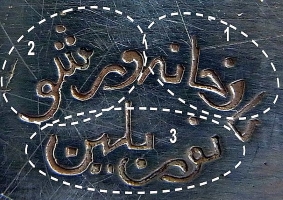
Next Norblin & Co mark was used on the silver-plated items, exported to Persia. It differs from the previous mark No.13 by the presence of an additional inscription in Persian.
Separately, the division of Persian inscription into three parts is shown: 1) Factory; 2) Warsaw; 3) Norblin. As usually, Persian inscription "Norblin factory in
Warsaw" goes from the right to the left. This mark is extremely rare and published for the first time.
|
|
15
|
1893 - 1896





The first N.B.W. mark which refers to the galvanic silver deposition. It differs from the previous mark No.13 by two characteristic details: firstly, by
the disappearance of two-headed eagle; and secondly, by using the abbreviation SKA (from Polish word Spolka) instead of Co. Note the long line under the abbreviation
"KA". Sometimes this long line is badly printed. Rather rare.
|
|
16
|
c.1896




After getting back the privilege of using the Coat of Arms of Russian Empire on its items, the N.B.W. company stamped all already issued (but yet unsold)
articles with the image of the double-headed eagle (version with a "glued" crown above the eagle). Note that the tale of the eagle nearly touches the oval. This
mark was used in 1896 and refers to the galvanic silver deposition. Rare.
|
|
17
|
c.1896 - c.1905





This N.B.W. mark refers to the galvanic silver deposition. It differs from the mark No.16 by one essential feature: the line under the abbreviation
"KA" is noticeably shorter than the one used between 1893 and 1896. The tale of the eagle nearly touches the oval. The mean size of the oval decreases down to
4.9 mm x 6.7 mm. Sometimes a rhombus with the letter "N" inside is applied, that means "normal thickness of silver deposited onto the surface of the base
metal". Common.
|
|
18
|
c.1905 - c.1915



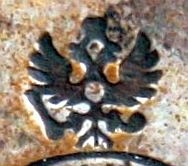

Next N.B.W. mark also refers to the galvanic silver deposition. It differs from the previous mark No.17 by the return from Polish inscription
"NORBLIN i SKA" to the English one "NORBLIN & Co". The mean size of the oval corresponds to that for the mark No.17, namely, 4.9 mm x 6.8 mm.
The letter "N" in a rhombus means "normal thickness of silver deposited onto the surface of the base metal". Rather rare.
|
|
19
|
c.1908 - c.1915


This mark of N.B.W. company was applied in the case of using the newly-invented tin alloy VERIT as a base metal for silvering. This use of this alloy
allowed to prepare the base details for future silvering by cheap casting, that decreasing the price of final silver-plated items. In addition, this tin-containing alloy
ideally corresponded to the design requirements imposed by fashionable (at that time) Art Nouveau style. This mark consists of convex triangle of 6.9 mm height and 7.5 mm
width. Inside the triangle under the Russian State Coat of Arms the two-line inscription "VERIT N.B.W." is made. Rather rare.
|
|
20
|
c.1909 - c.1915




This is the first Norblin/N.B.W. plate mark (for the rolled silver deposition) issued since 1882, maybe due to the 100 year jubilee of N.B.W. celebrated in 1909.
It differs from the mark No.18 by the printing of two main mark elements, the oval and the two-headed eagle, as bas-reliefs on a flat surface. In the centre of the oval
instead of the word "GALW." the word "PLATER" is placed. Rare.
|
|
21
|
c.1909 - c.1915





This Jubilee N.B.W. mark refers to the galvanic silver deposition. It differs from the previous mark No.18 by the printing of two main mark elements, the oval
and the two-headed eagle, as bas-reliefs on a flat surface. The size of the oval varies between 4.4 mm x 5.8 mm and 5.3 mm x 7.1 mm. The letter "N" inside a
rhombus (or inside a small oval) means "normal thickness of silver deposited onto the surface of the base metal". Relatively common.
|
|
22
|
c.1909 - c.1915


The Jubilee mark of N.B.W. foundry, used on the silver-plated items, exported to Persia. It differs from the previous mark No.21 by the
additional Persian inscription "Norblin factory in Warsaw". This mark is extremely rare and published for the first time.
|
|
23
|
c.1915





The variations of N.B.W. marks Nos.18 & 21 without the Russian State Coat of Arms were used immediately after Poland have declared its independence of Russian Empire.
Very rare.
|
|
24
|
c.1915 - c.1925





This N.B.W. mark for the galvanic silver deposition, used in the first decade of independent Polish State, looks very similar to the mark No.16, used between
1896 and 1905 (see above). Nevertheless, one important detail allowed us to distinguish these two marks, namely, a striking difference in writing the last letter "W"
in the word "GALW". While the mark No.16 (and all other (!) Norblin and N.B.W. marks for galvanic silver deposition, used between 1863 and 1915) has all three peaks
of "W" letter of the same height, in the mark No.24 we clearly see that the middle peak of the "W" letter displays a noticeably lower height. Common.
|
|
25
|
c.1915 - c.1925

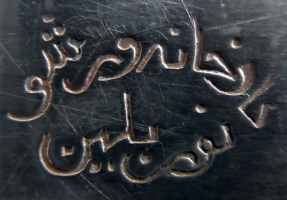
The N.B.W. mark used on the silver-plated items, exported to Persia. It differs from the previous mark No.24 by the additional Persian inscription
"Norblin factory in Warsaw". Very rare.
|
|
26
|
c.1915 - c.1925


The second VERIT mark of N.B.W. company, which was used after 1915. Note the absence of the Russian State Coat of Arms. Rather rare.
|
|
27
|
c.1925 - c.1939






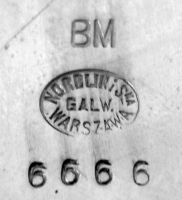
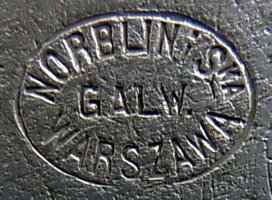

The last N.B.W. foundry mark for the galvanic silver deposition, used before the World War II. In comparison with the previous mark No.24, in this mark all
three "W" letters (one in the inscription "GALW" and two others in the word "WARSZAWA") are subject to have the middle peak in the
"W" letter of a lower height. The following types of disposition were found: 1) all three "W" letters have the middle peak of a lower height; 2) two
"W" letters in the world "WARSZAWA" have the middle peak of a lower height; 3) two "W" letters, one in the inscription "GALW" and
other in the word "WARSZAWA", have the middle peak of a lower height. The presented pictures illustrate all three cases discussed.
|
 |
A silver-plated sugar bowl issued between 1893 and 1915 by Bros. Buch company.
Private collection of David N. Nikogosyan.
|
Marks of Bros. Buch foundry (c.1865 - 1915).
|
N°
|
PERIOD, MARK & COMMENT
|
|
1
|
c.1865 - 1872


Early mark of Bros. Buch, which refers to the galvanic silver deposition (silver plating on brass base). It consists of German inscription "GEBR ВUCH
WARSCHAU", that means the shortening of "GEBRÜDER ВUCH WARSCHAU" (in English "BROTHERS BUCH WARSAW"), put in a cartouche of fancy shape. The size
of a cartouche is about 3.8 mm x 9.7 mm. Below, a catalogue number is given. Rather common.
|
|
2
|
1872 - 1882



Next mark of Bros. Buch, which refers to the galvanic silver deposition (silver plating on brass base). It consists of the Polish inscription "ВR. BUCH
w WARSZAWIE", which is the shortening of "ВRACIA BUCH w WARSZAWIE" (in English "BROTHERS BUCH in WARSAW"), put in a cartouche of fancy shape which
is similar to that used in mark No.1. Above the cartouche there is an image of the Russian State Coat of Arms, two-headed eagle. Below, a catalogue number is given. Rather
common.
|
|
3
|
c.1882

An extremely rare Bros. Buch mark from the period 1872-1882, which is over-printed with the Norblin mark from the same period. It could only have happened
in 1882, when the Bros. Buch firm was absorbed by Norblin & Co. Interestingly, the Norblin oval was stamped just above the two-headed eagle, showing that this privilege
had disappeared (as the company name was changed). Later in the same year, when Norblin & Co together with Bros. Buch got again such a privilege, a new triangular mark for
Bros. Buch division was created (see below). Published for the first time.
|
|
4
|
1882 - c.1893



A standard mark of Bros. Buch company used after the absorption by Norblin foundry, which refers to the galvanic silver deposition. It consists of the Polish
inscription "B. BUCH", which is a shortening of "ВRACIA BUCH" (in English "BROTHERS BUCH"). Above there is another Polish inscription
"W.M.F. WARSZAWA GALW.", made by a "serif" font and put inside the triangle. Some researchers suppose that the abbreviation W.M.F. refers to famous Württembergische Metallwarenfabrik (in
English Wurtemberg Metalware Factory). However, the widely-used abbreviation of this factory is WMF (and not W.M.F.!). Besides, in 1882, the WMF was only at very early
stage of its development (founded in 1880). The inscription "GALW. " in a triangle is the shortening of the Polish word "GALWANIZACJA"
("GALVANIZATION"), which refers to the method of silver deposition on the surface of a base metal (usually, on brass). Note the dot at the end of the inscription
"GALW". At the top of the triangle there is a small six-pointed Star of David. Inside the triangle, there is a Roman digit II, the meaning of it is not clear. Below,
a catalogue number is given. Common.
|
|
5
|
c.1893 - c.1915




The next mark of Bros. Buch company after the absorption by Norblin firm refers to the galvanic silver deposition. Like the previous Mark No. 4, it consists
of the Polish inscription "B. BUCH" under another Polish inscription "W.M.F. WARSZAWA GALW. ", put inside the triangle. However, in the case of Mark No.5,
sometimes the inscription "B. BUCH" and the triangle are glued together. Interestingly, in Mark No.5 the inscription "B.BUCH" is presented more tightly than
the similar inscription in Mark No.4. To prove this finding, we have calculated the mean ratio of the length of word BUCH to its height for 13 marks, belonging to different
items issued in 1893-1915, and established, that it is equal to 2.9. The similar procedure, made for 10 marks, belonging to different items produced by Brothers Buch in
1882-1893, showed that in this case the mean ratio is noticeably higher (4.0). We should note also, that in Mark No.5 all the inscriptions (inside and outside the triangle)
are made by a "sans serif" font. Attention! At the top of the triangle there is a small five-pointed star (not a six-pointed star like in Mark No.4). Very common.
|
|
6
|
c.1893 - c.1915

The mark of Bros. Buch foundry, which was used on the silver-plated items, exported to Persia. It differs from the previous mark No.5 by the additional
Persian inscription "Norblin factory in Warsaw", which is equivalent to Persian inscription used by Norblin/N.B.W in Marks Nos.14, 22 and 25. This Bros. Buch mark
is extremely rare and published for the first time.
|
|
7
|
c.1893 - c.1915


The simplified version of the export Mark No.6. Contains a shorten inscription in Persian, namely, "Norblin". It should be noted that in the mark
this inscription is given up-side down. The correct disposition of Persian inscription is given separately. Extremely rare.
|
|
8
|
c.1909 - c.1915

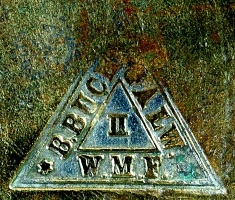

Last mark of Bros. Buch company, issued to celebrate the 100-year anniversary of this enterprise. It refers to galvanic silver deposition and consists only
of triangle. The inscription "В. BUCH" is put inside the triangle together with two other inscriptions "W.M.F. " and "GALW.". Interestingly,
this inscription is made by a "serif" font, while all above mentioned inscriptions "B. BUCH" are made using a "sans serif" font. Contrary to the
previous triangle marks, this one contains three (!) six-pointed Stars of David. This mark is extremely rare and published for the first time.
|
LITERATURE
[1] Maria Ejchmann, Platery. Katalog Zbioru Platerow Warszawskich im. Anieli i Tadeusza Wysiadeckich (Warszawa: Muzeum Woli, 2005), pp.1-107 [in Polish]. English translation of the title:
Warsaw Silver Plate. Catalogue of the collection, gathered by Aniela and Tadeusz Wysiadecki.
[2] T.B. Wysiadecki, Platery Warszawskie. I. Bracia Buch (Warszawa: TAD,1992), pp.1-24 [in Polish]. English translation of the title: Warsaw Silver Plate. I. Brothers Buch.
David N. Nikogosyan and Joanna Paprocka-Gajek
- 2016 -
|
|


















































































































